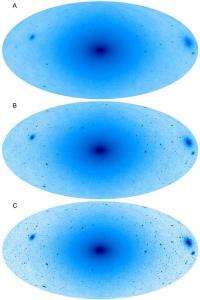August 10, 2009 feature
Dark Matter May be Easier to Detect than Previously Thought

(PhysOrg.com) -- The Milky Way, like many other galaxies, is thought to be embedded in massive, lumpy amounts of dark matter that release gamma rays and other emissions. Although at first these emissions seem too faint to detect, recent observations have shown that they may be stronger than previously thought. In a new study, scientists have developed a model that predicts that gamma rays from hundreds of dark matter clumps should be detectable by the Fermi satellite that was launched in June 2008.
In their study published in a recent issue of Science Express, Michael Kuhlen of the Institute for Advanced Study in Princeton, Piero Madau of the University of California, Santa Cruz, and Joseph Silk of the University of Oxford have investigated how the luminosity from cold dark matter annihilations can be enhanced by orders of magnitude by the Sommerfeld effect. While previous calculations have shown that only a handful of the most massive dark matter halos should emit gamma rays detectable by satellites, accounting for the Sommerfeld effect suggests otherwise.
“Annihilation is a quantum mechanical process that can occur whenever a particle and its antiparticle collide,” Kuhlen told PhysOrg.com. “It turns out that in many promising particle physics models the dark matter particle is its own antiparticle. In that case you only need to get to sufficiently high densities for dark matter particles to have a reasonable chance to collide with each other and hence to annihilate. It turns out that the predicted dark matter densities at the centers of subhalos are high enough that a large enough number of annihilation events might occur for Fermi to have a chance to detect the resulting radiation. Especially if the Sommerfeld effect is important.”
As the researchers explain, the Sommerfeld effect is the result of a long-range attractive force between dark matter particles that effectively increases the dark matter annihilation rate. When analyzing the experimental results of other satellites, researchers discovered a surprisingly large amount of electron and antimatter emissions. The Sommerfeld effect, they suggest, might explain these puzzling signals.
To explore this possibility, the researchers applied the Sommerfeld correction to simulations that use more than one billion particles to model the formation of a dark matter halo the size of the Milky Way. They found that, after they applied the corrections, smaller subhalos (and even smaller “subclumps”) are much more clearly visible than in previous predictions. When compared to expected backgrounds, the researchers predict that, even in conservative cases, ten or more subhalos should be discovered after five years of searching by the Fermi satellite. They also predict that Fermi should be able to detect some of these subhalos in its first year of observation, a prediction that will soon be tested.
If the researchers are correct, dark matter detections could open up the door to interesting possibilities such as non-gravitational dark matter interactions and new particle physics.
“That would be a spectacular confirmation of the particle nature of dark matter [if the Fermi satellite does detect dark matter annihilation],” Kuhlen said. “It would certainly result in a Nobel Prize for someone on the Fermi team. Don't forget that we have no direct evidence of dark matter. Over the last 70-80 years astronomers have amassed numerous independent observational pieces of evidence for its existence, and particle physics theory provides many plausible particle candidates. As a result, dark matter is a firm part of the standard paradigm of cosmological structure formation. Nonetheless, it would be great to get some more direct confirmation of this hypothesis. Detecting the products of dark matter annihilation would provide such evidence. Furthermore it would shed light on the nature of the dark matter particle: its mass and its annihilation cross section, for example.”
More information: Michael Kuhlen, Piero Madau, Joseph Silk. “Exploring Dark Matter with Milky Way Substructure.” Science Express. 10.1126/science.1174881.
Copyright 2009 PhysOrg.com.
All rights reserved. This material may not be published, broadcast, rewritten or redistributed in whole or part without the express written permission of PhysOrg.com.




















